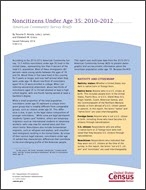Noncitizens Under Age 35: 2010-2012
Noncitizens Under Age 35: 2010-2012
According to the 2010-2012 American Community Survey, 10.3 million noncitizens under age 35 lived in the United States, representing less than 4 percent of the total U.S. population. Most of these immigrants—80 percent—were young adults between the ages of 18 and 34. About three in five have lived in this country for 5 years or longer, and over half arrived when they were under age 18. About one-third of noncitizens aged 18 to 24 were enrolled in college. When considering educational attainment, about two-thirds of noncitizens aged 25 to 34 had attained at least a high school degree, with one-fourth having earned at least a bachelor’s degree.
While a small proportion of the total population, noncitizens under age 35 represent a unique immigrant group that is notably different from comparable groups, such as citizens under age 35. This difference is due, in part, to the legal status composition of younger noncitizens.1 While some are legal permanent residents (“green card” holders), others are temporary migrants—such as international students or temporary workers—who may stay for several years and then return home. Noncitizens also include humanitarian migrants, such as refugees and asylees, and unauthorized immigrants residing in the United States. By virtue of their various legal statuses, noncitizens under age 35 exhibit key characteristic differences that contribute to the ever-changing profile of the American people.
This report uses multi-year data from the 2010–2012 American Community Survey (ACS) to present demographic and socioeconomic information about the noncitizen population under age 35. Because the ACS does not include a question on legal status, this report compares only the characteristics of citizens—including both native born and naturalized foreign born—with noncitizens. It begins by discussing the distribution of the total population by citizenship status and age, then reviews the geographic distribution of noncitizens under age 35 by state and metropolitan statistical area. The labor force participation, employment status, and occupation distribution of both citizens and noncitizens aged 25 to 34 are then compared. The report closes with a discussion of selected demographic and educational characteristics of noncitizens under age 35, which includes median age, age at arrival to the United States, years since entering the United States, college enrollment, and educational attainment.
__________
1 In this report, the terms “younger noncitizens,” “young noncitizens,” and the “young noncitizen population” all refer to noncitizens under age 35.
Others in Series
Publication
Publication
Publication




